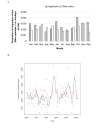Epidemiology of impaction colic in donkeys in the UK
- PMID: 17274808
- PMCID: PMC1800892
- DOI: 10.1186/1746-6148-3-1
Epidemiology of impaction colic in donkeys in the UK
Abstract
Background: Colic (abdominal pain) is a clinical condition of serious concern affecting the welfare and survival of donkeys at the Donkey Sanctuary in the UK. One of the most commonly reported causes is due to impacted ingesta in the large intestine ("impaction colic"). However little is known about the incidence of, or risk factors for, this condition. Here we describe the epidemiology of colic in donkeys, specifically impaction colic. We focus on temporal aspects of the disease and we identify environmental and management related risk factors for impaction colic in UK donkeys.
Results: There were 807 colic episodes in the population of 4596 donkeys between January 1st 2000 and March 31st 2005. The majority (54.8%) of episodes were due to a suspected or confirmed diagnosis of impaction of the gastrointestinal tract. The mortality risk for all colics (51.1%) was higher than reported in other equids. The incidence rate of all colics (5.9 episodes per 100 donkeys per year) and of impaction colic (3.2 episodes) was similar to that in horses. A retrospective matched case-control study of all impaction colics from January 2003 (193) indicated that older donkeys, those fed extra rations and those that previously suffered colic were at increased risk of impaction. Lighter body weight, musculo-skeletal problems, farm and dental disease were also significantly associated with a diagnosis of impaction colic.
Conclusion: To our knowledge this is the first study to estimate the incidence rate of colic in a large population of donkeys in the UK. In contrast to other equids, impaction was the most commonly reported cause of colic. We identified several risk factors for impaction colic. Increasing age, extra rations and previous colic are known risk factors for colic in other equids. Results support the hypothesis that dental disease is associated with impaction colic. Musculo-skeletal problems may be associated with colic for various reasons including change in amount of exercise or time at pasture. Other associated factors (weight and farm) are the subject of further research. Identification of risk factors for impaction colic may highlight high risk donkeys and may allow intervention strategies to be introduced to reduce the incidence of the disease.
Figures

Similar articles
-
Case control study to investigate risk factors for impaction colic in donkeys in the UK.Prev Vet Med. 2009 Nov 15;92(3):179-87. doi: 10.1016/j.prevetmed.2009.08.012. Epub 2009 Sep 15. Prev Vet Med. 2009. PMID: 19758718
-
Clinical dental examinations of 357 donkeys in the UK. Part 2: epidemiological studies on the potential relationships between different dental disorders, and between dental disease and systemic disorders.Equine Vet J. 2009 Apr;41(4):395-400. doi: 10.2746/042516409x368903. Equine Vet J. 2009. PMID: 19562903
-
Demographics, management and health of donkeys in the UK.Vet Rec. 2010 May 1;166(18):552-6. doi: 10.1136/vr.b4800. Vet Rec. 2010. PMID: 20435979
-
Treatment of impaction colics.Vet Clin North Am Equine Pract. 1997 Aug;13(2):243-59. doi: 10.1016/s0749-0739(17)30239-0. Vet Clin North Am Equine Pract. 1997. PMID: 9290183 Review.
-
Dental Disorders of Donkeys.Vet Clin North Am Equine Pract. 2019 Dec;35(3):529-544. doi: 10.1016/j.cveq.2019.08.008. Epub 2019 Oct 3. Vet Clin North Am Equine Pract. 2019. PMID: 31587975 Review.
Cited by
-
A functional approach to the body condition assessment of lactating donkeys as a tool for welfare evaluation.PeerJ. 2017 Mar 28;5:e3001. doi: 10.7717/peerj.3001. eCollection 2017. PeerJ. 2017. PMID: 28367363 Free PMC article.
-
Owners' Knowledge and Approaches to Colic in Working Equids in Honduras.Animals (Basel). 2021 Jul 13;11(7):2087. doi: 10.3390/ani11072087. Animals (Basel). 2021. PMID: 34359215 Free PMC article.
-
Equine colic: clinical epidemiology and associated risk factors in and around Debre Zeit.Trop Anim Health Prod. 2017 Jun;49(5):959-965. doi: 10.1007/s11250-017-1283-y. Epub 2017 Apr 11. Trop Anim Health Prod. 2017. PMID: 28401328
-
Gastrointestinal Disorders of Donkeys and Mules.Vet Clin North Am Equine Pract. 2019 Dec;35(3):419-432. doi: 10.1016/j.cveq.2019.08.001. Epub 2019 Oct 3. Vet Clin North Am Equine Pract. 2019. PMID: 31587977 Free PMC article. Review.
-
A Survey of Smallholder Farms Regarding Demographics, Health Care, and Management Factors of Donkeys in Northeastern China.Front Vet Sci. 2021 Apr 14;8:626622. doi: 10.3389/fvets.2021.626622. eCollection 2021. Front Vet Sci. 2021. PMID: 33937368 Free PMC article.
References
-
- Sanctuary TD. The Donkey Sanctuary Working WorldWide http://www.thedonkeysanctuary.org.uk/site/1/Working_Worldwide.html
-
- Duffield HF, Bell N, Henson FMD. In: Factors associated with impactive colic in the donkey: 14-16 July; Manchester, UK. BEVA , editor. Equine Veterinary Journal Ltd; 2002. p. 122.
-
- Duffield HF, Bell N, Henson FMD. In: The common presenting signs and causes of colic in the donkey: 11-14 September; Glasgow, UK. BEVA , editor. Equine Veterinary Journal Ltd; 2002. p. 214.
-
- Crane M. Medical. In: Svendsen ED, editor. The Professional Handbook of the Donkey. 3rd. London , Whittet Books Ltd; 1997. pp. 19–35.
Publication types
MeSH terms
LinkOut - more resources
Full Text Sources

